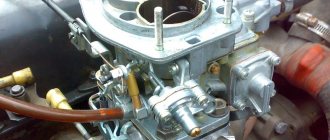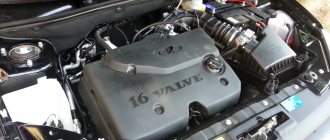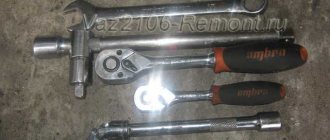Design and principle of operation of the solenoid valve
The solenoid valve, also called the forced idle economizer (IAF), is an integral component of any carburetor in modern cars. The active use of this unit began in the 80s of the last century, when the “battle” between injection and carburetor units intensified. This is largely due to the fact that the former had noticeably lower fuel consumption, and this already captivated a larger number of motorists.
In order to minimize the consumption of carburetor engines, automotive engineers began to actively electronize them. In a few words, the essence of the latter was to reduce fuel consumption through the use of electronic devices. As a result, electronization resulted in the appearance of a carburetor solenoid valve, as well as a number of other electrical devices in the design of this unit. But why was this necessary and how did it help the competition between carburetor engines and injection engines? In order to answer this question, it is worth paying attention to the operating principle of the EPH.
So, the carburetor solenoid valve is a device that runs on electric current and performs very specific functions. More precisely, it works to organize stable and optimal idle speed in the so-called forced mode of engine operation. The essence of the optimization is that when the engine operates in modes that do not require fuel consumption (switching to a lower gear, coasting, etc.), the EPHH turns off its supply without involving the throttle valve in the movement at all. This happens by transferring fuel through special channels at idle. During this transportation, only the idle jets, valves and some paths in the carburetor function, that is, its chambers and throttle valve are completely inactive.
As a result, we succeed:
- firstly, save fuel when the engine operates in the previously noted forced running mode;
- secondly, organize a stable and optimized idle speed;
- thirdly, to ensure high-quality and problem-free engine warming up for the driver during startup (by increasing the fuel supply with the same EPH);
- fourthly, eliminate unnecessary functioning of the throttle valve and a number of other components in the carburetor;
- and fifthly, optimize the operation of the entire motor, which significantly extends its service life.
Note that the economizer operates under the control of a special unit called the “carburetor solenoid valve control unit.” This device constantly analyzes the operation of the motor, based on sensor readings (speed, engine temperature, etc.), after which it gives appropriate instructions directly to the EPHH, and it, in turn, through the movement of the rod (small needle) either closes to the desired position fuel supply channels at idle, or vice versa, opens them. In general, there are no particular difficulties in a working economizer, which is clearly shown by the description of the device presented above. For even greater clarity of everything described, we recommend that you familiarize yourself with the following pictures:
Connection diagram for a typical EPHH:
Operating principle of the valve together with the control unit:
Principle of operation
Next up is the question of how the idle air system valve, that is, the idle air regulator, works on car engines.
The KXX itself is an electromechanical actuator, which is controlled and controlled by the engine ECU. The latter supplies electrical signals, due to which the valve opens or closes. In this case, the diameter of the flow section of the idle channels changes, through which the required volume of air or fuel for the internal combustion engine enters the intake manifold.
To understand the operating principle on which the operation of the idle air control valve is based, it is worth considering the unit on different types of engines.
Carburetor
Carburetors running on gasoline must have such a solenoid valve. It is located in the carburetor body itself and is an integral part of the forced XX economizer.
This valve is controlled through the economizer control unit, which is located in the engine compartment. When you turn on the ignition, power is supplied from the unit to the regulator, it opens and supplies fuel to the manifold through the idle channel. By turning off the ignition, the power supply to the valve is stopped, and therefore the fuel supply is cut off.
To select the optimal volume of fuel for supply to the XX channel, the carburetor design provides a special adjustment screw.
This screw received a completely logical name and is referred to as the idle screw.
Injector
For gasoline injectors, the operating principle of the XX regulator is somewhat different. Structurally, it is located in the throttle body and is part of the electronic control system of the internal combustion engine.
The ECU is responsible for the operation of the valve. It records signals coming from monitoring installed sensors, processes the data and transmits control signals directly to the regulator itself. Due to commands from the ECU, the IAC can increase or decrease the volume of air entering the engine manifold, thereby maintaining the set speed.
Diesel
In the case of a diesel engine, the solenoid valve is located in the housing of the injection pump, that is, the high-pressure fuel pump. As in the case of the injector, there is a connection between the IAC and the internal combustion engine ECU.
A distinctive feature of a diesel engine is the regulation of the supply of fuel, and not air, to control engine speed.
Otherwise, the operating principle is similar to a gasoline injector.
Correct installation of the EM valve
It would seem, well, what’s so difficult, I screwed the valve into the carburetor and that’s it, but there are some nuances unknown to many, so if you do the installation yourself, without following them, you get new problems. So:
- It is extremely important to correctly screw the EMC onto the carburetor
- The most popular misconception is that it can only be tightened by hand.
- Moreover, this can be heard not only from a beginner, but also from middle-aged and very experienced specialists in reputable car services
- After such a recommendation, you and other drivers are in the deepest misconception
- The point here is that a valve that is loosely tightened (by hand) begins to dangle in the thread, and a poorly squeezed rubber band adds additional air leakage, which leads to a lean mixture - just one of the common reasons for unstable speed
- A similarly erroneous technique was proposed in an article titled “Capricious Valve” in a magazine titled “Behind the Wheel”:
- Let the engine idle, while turning off the power supply to the valve
- We tighten it little by little until the combustible mixture normalizes and the speed increases; if the engine stalls, this means that the valve is tightened
- Then start the engine and check the operation of the valve by disconnecting and connecting the power supply
- The whole point here is that the engine will stall as soon as the end of the nozzle has just begun to enter its seat, but it has not yet reached the end
- This “wisest” recommendation is also complemented by: “If necessary, you can tighten the EMC by about one more turn.”
- Doing this is just dangerous - if you squeeze the EMC, you can ruin the XX jet, or ruin the seat for the jet, which is even worse, and if you break the thread located in the carburetor cover, then the cost of repair will skyrocket
Symptoms of a problem
There are several main signs indicating failure of the EPHH:
- The engine regularly stalls at idle;
- Detonation occurs in the engine when the ignition is turned off;
- The engine stalls when coasting braking is performed.
You can check whether the EPHH and its control unit are working correctly with your own hands. To check the valve, you should monitor its activation in various operating modes. Correct operation is determined by ear or using a voltmeter.
Independent examination of the valve condition
A detailed check of the functioning of the needle is possible only after dismantling the element under test. You must first remove the air filter and the filter element housing itself. The switch is unscrewed with a regular open-end wrench 13, carefully removed from its seat, and the analog element that dispenses the amount of fuel is removed.
The range of actions for a full diagnosis is as follows:
- pre-prepared conductors are connected to the battery terminals;
- “plus” is connected to the terminal, and “minus” is connected to the body of the part;
- The device reacts after voltage is applied.
dampers The shut-off needle is unprecedentedly retracted into the device body in the presence of a potential difference and instantly returns to its original position - the device is subject to further operation.
By turning on the ignition and closing the VAZ 2109 solenoid valve to the carburetor (body to body), with a known working EPHH control system, it is easy to assess the suitability of the locking element. As a result of contact with the “ground”, the needle should go inside the body with a characteristic click. Experienced owners test a newly purchased switch in this way.
- before screwing the device back in, the fuel nozzle should be washed/blown out;
- if the precision holes are heavily soiled, it is necessary to clean them with a fishing line or a soft wood needle;
- a loose valve may make it impossible to start the engine when the crankshaft is rotating;
- When tightening the element, you should not apply great forces, leading to deformation of the actuators of the part.
Solenoid valve for carburetor VAZ 21083
- We guarantee fast processing of your order during business hours (we work from 11-00 to 20-00, Saturday and Sunday are days off).
- We guarantee reliable packaging of your order (when sending it by Russian Post or transport company).
- We guarantee the fastest possible dispatch of your paid order (within 2-4 business days after receipt of payment).
- We guarantee a refund or exchange for another product (with recalculation) within 14 days from the date of receipt of the order (the product must be in good condition, without traces of installation, delivery costs are not reimbursed).
- We guarantee a free exchange of goods (transportation costs at our expense) if the purchased goods turn out to be defective.
Payment Methods
Delivery in Russia and abroad
Pickup in Moscow
- Description
- Reviews
APPLICABILITY: VAZ 2108, 2109, 21099, VAZ 2110, 2111, VAZ 2115, VAZ 21213, 2131 (Niva) with a carburetor engine.
Standard solenoid valve for any SOLEX carburetor.
The presence or absence of idle speed on carburetor engines of VAZ cars often depends on the serviceability of the carburetor solenoid valve. If you have any problems with the engine idle speed, the first thing to check is the solenoid valve.
The verification is carried out in 4 stages:
1
. Turn on the ignition, but do not start the engine.
2
. Remove the tip of the wire from the output of the solenoid valve (Thus, de-energize it. The shut-off needle is in the forward position and blocks the hole for supplying the fuel mixture to the idle system).
3
. Place the tip of the wire on the terminal of the solenoid valve (Apply voltage. A click should be heard. The shut-off needle is retracted into the valve body and opens the fuel supply hole to the idle system).
4
. We connect a piece of wire between the plus of the battery and the terminal of the solenoid valve (A click appears - the electrical circuit is faulty. There is no click - the valve needs to be replaced).
Device diagnostics
Motorists are interested in how to check the idle air valve themselves and its current condition.
For many car enthusiasts, independently checking this valve, a component of the idle air system, is a completely doable task. There are several methods for diagnosing the condition of the regulator.
- Visual inspection. First a visual inspection is carried out. This allows you to determine the presence of defects on the body, signs of needle wear, and signs of carbon deposits on surfaces. If there are deposits, they can be removed using carburetor cleaner. Surely, if the IAC is dirty, the entire throttle assembly will be dirty. Therefore, it will not be superfluous to clean it too.
- Diagnostic software. Some car enthusiasts are switching to using special diagnostic programs. In addition to the software, an adapter is also required to connect to the system. Through the software menu, the position of the controller is selected and its operation is observed.
- Wiring condition. It would not be superfluous to carefully check the wiring connected to the IAC. Here you need to use a multimeter. The engine is turned off, the sensor connector is removed. On the multimeter, select the voltage test mode with a limit from 0 to 20 V. When working properly, the device should show about 12 V.
- Resistance. The resistance of this regulator is also checked. To do this, using the same multimeter, the resistance between the terminals is checked by disconnecting the sensor terminals. The multimeter is turned on in resistance mode, and the limits are set from 0 to 200 Ohms. The terminals are conventionally designated as A, B, C and D. When measuring resistance at A and C, as well as at B and C, the device should display infinity. In other cases, 50-55 Ohms is considered the norm.
- Check with throttle. Checking with the throttle assembly is also quite common among motorists. The complexity of the method is that you will have to completely dismantle the entire throttle assembly directly along with the sensor itself. After connecting the IAC connector, turning the ignition on and off, visually observe the operation of the suspected regulator. Make sure that the needle moves normally, the stroke is uniform, and there are no extraneous sounds.
In most cases, when the IAC fails, it is replaced with a similar part.
Carburetor solenoid valve - how does it work?
- Carburetor solenoid valve - how does it work?
- 1. What causes excessive consumption of gasoline?
- 2. What does a carburetor solenoid valve do?
- 3. How does the solenoid valve of the VAZ 2107 work?
Carburetor engines are a type of internal combustion engine. These engines have external mixture formation and autonomous ignition. In an engine of this type itself, a ready-made air-fuel mixture will be sent to its cylinders, which is prepared in the carburetor device, which is why, in fact, such an engine received the name of the same name. In addition, such a procurement process can occur through fuel injection, in a gas-air mixer, etc.
- 1. What causes excessive consumption of gasoline?
- 2. What does a carburetor solenoid valve do?
- 3. How does the solenoid valve of the VAZ 2107 work?
Regardless of the method of formation of the mixture, as well as the number of strokes into which the working cycle is divided, a carburetor engine has one single operating principle. The directly combustible mixture, which is compressed in the combustion chamber, is ignited by the ignition system at a certain moment, often through an electric spark system. In addition, ignition from a glow tube can be used, which in modern times is found in small-sized internal combustion engines. Currently, plasma and laser ignition are also used, albeit at an experimental level.
Electrical voltage is applied directly to the solenoid coil of the valve, as a result of which the magnetic core begins to be drawn into the solenoid. This procedure will close or open the system valve. The core itself moves inside the solenoid coil tube, which is necessary to increase the sealing component of the solenoid valve. This device is similar to a conventional shut-off valve. The only difference is that in such a device, closing and opening the valve does not use any mechanical force, since it occurs through an electromagnetic coil by applying electrical voltage to it.











